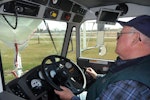What's inside the Ford Lightning electric pickup truck?
I was headed to Port Huron, Michigan, where the Blue Water Bridge would take me into Sarnia, Ontario, had I been planning to visit Canada, which I wasn't. I just wanted to take a look at that span because its name sounded romantic, but I’d never been far enough into Michigan to see it. It was also a way to put some miles on the Lightning, which Ford agents had delivered to me that morning in Bloomfield Hills, about 60 miles to the south.
The e-truck’s comfort made it a pleasurable drive. The quiet powertrain allowed me to observe other characteristics, including vast amounts of interior room, considerable storage inside the wide center console and the dash ahead of it, where pockets and shelves were molded into the plastic material.
I also tested some of the electronic driver-assist features. One was Lane Keeping Assist, which guided the vehicle in its travel lane with little or no input from me on the steering wheel. It did a really decent job of keeping the truck centered between the stripes on either side and following them through slight curves. There was a slight delay as the steering reacted to those directional changes, and I sometimes moved the wheel to compensate. On the Interstate, the assist was “hands free,” and I could lay my hands on my lap or wherever I wanted. Not on lesser roads.
The system included a camera that watched what I was watching and told me to get back to watching the road. This happened once when I was using the big touch screen to adjust the A/C and tune the satellite radio. These and many other functions must be controlled with the screen, and suffice it to say that I’d much prefer separate knobs that I can quickly glance at and adjust, like the rotary headlamp switch.
The Lightning has a motor on each axle, which automatically makes it a 4x4. I never had occasion to test that capability, though I did note that the tires were rib types not suited for any serious off-roading. Surveys show that few 4x4 pickups ever leave pavement, though all-wheel-drive traction is useful on wet or snowy pavement.
The motors also act as generators, sending voltage to the battery pack while slowing down and braking. This adds some range, and “range anxiety” —fear of running the battery down—is one of the reasons people haven’t flocked to buy EVs in general. Readouts on the dash display constantly showed percentage of charge and miles remaining with it.
I wanted to be courteous and recharge the battery before turning in the truck, so that evening I checked Google Maps for the locations of charging stations. There were quite a few, including one that was supposed to be right around the corner from my hotel, but it wasn’t there.
The next morning, I found four chargers at a motorsports complex in Pontiac. The first one was not operating, but the next one in line was. To use it I had to download a ChargePoint app onto my phone, but registering it required a username and password. That’s an example of the frustrations that EV buyers will face until they learn the ropes, or cords in this case.
The truck went back to Ford less than half charged.








